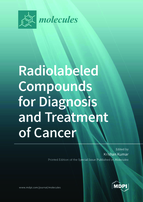Radiolabeled Compounds for Diagnosis and Treatment of Cancer
A special issue of Molecules (ISSN 1420-3049). This special issue belongs to the section "Medicinal Chemistry".
Deadline for manuscript submissions: closed (30 June 2021) | Viewed by 46979
Special Issue Editor
Interests: radiotracers; drug discovery; drug development; biomarkers; end point; therapeutic effect; drug efficacy
Special Issues, Collections and Topics in MDPI journals
Special Issue Information
Dear Colleagues,
Significant advances in the design and evaluation of novel radiopharmaceuticals in preclinical and clinical environments have allowed for wider adoption of imaging technologies, such as SPECT and PET, and treatment of various cancers. Numerous radiopharmaceuticals have become available commercially for various applications, and more are going through development and the regulatory approval process. These radiopharmaceuticals are critical to the diagnosis and staging of diseases as well as the selection of patients for various therapies and the monitoring of their outcomes.
The editorial team of Molecules is developing a Special Issue titled “Radiolabeled Compounds for Diagnosis and Treatment of Cancer”. This Special Issue will focus on all aspects of design, characterization, evaluation, and development of novel radiolabeled compounds for the diagnosis and treatment of cancer and the application of new radiochemistry and methodologies for the development of novel radiolabeled compounds.
Submissions—both original research papers and reviews—related to the areas mentioned above are cordially invited.
Prof. Dr. Krishan Kumar
Guest Editor
Manuscript Submission Information
Manuscripts should be submitted online at www.mdpi.com by registering and logging in to this website. Once you are registered, click here to go to the submission form. Manuscripts can be submitted until the deadline. All submissions that pass pre-check are peer-reviewed. Accepted papers will be published continuously in the journal (as soon as accepted) and will be listed together on the special issue website. Research articles, review articles as well as short communications are invited. For planned papers, a title and short abstract (about 100 words) can be sent to the Editorial Office for announcement on this website.
Submitted manuscripts should not have been published previously, nor be under consideration for publication elsewhere (except conference proceedings papers). All manuscripts are thoroughly refereed through a single-blind peer-review process. A guide for authors and other relevant information for submission of manuscripts is available on the Instructions for Authors page. Molecules is an international peer-reviewed open access semimonthly journal published by MDPI.
Please visit the Instructions for Authors page before submitting a manuscript. The Article Processing Charge (APC) for publication in this open access journal is 2700 CHF (Swiss Francs). Submitted papers should be well formatted and use good English. Authors may use MDPI's English editing service prior to publication or during author revisions.
Keywords
- Radiopharmaceuticals
- Imaging pharmaceuticals
- Diagnosis of cancer
- Treatment of cancer
- Radiolabeled compounds
- Preclinical
- Radiochemistry
- Radiolabeling
- Methodologies







